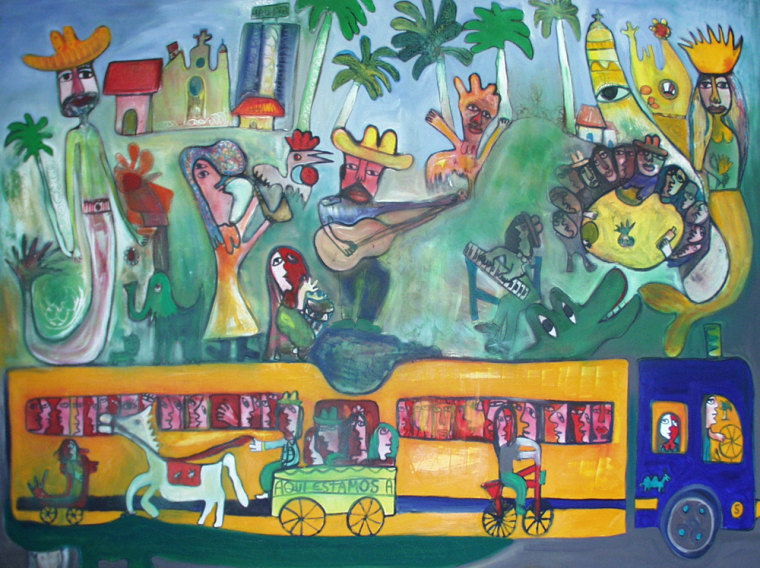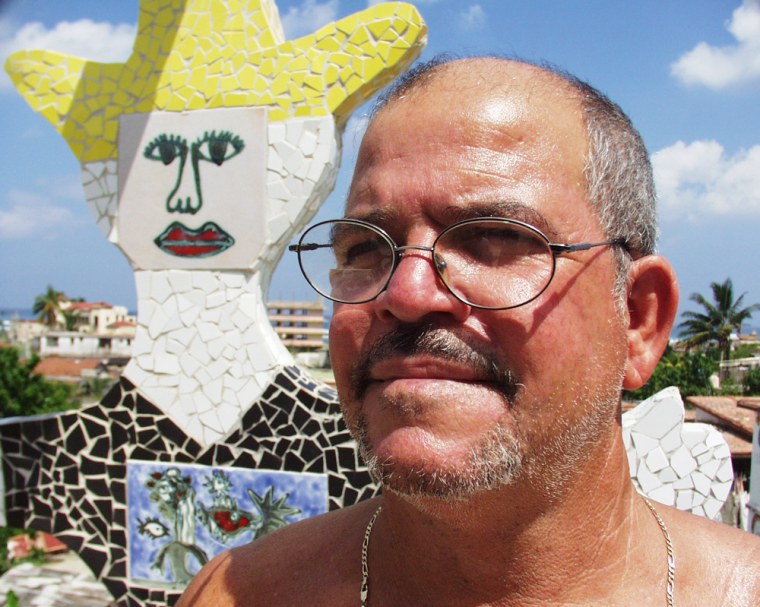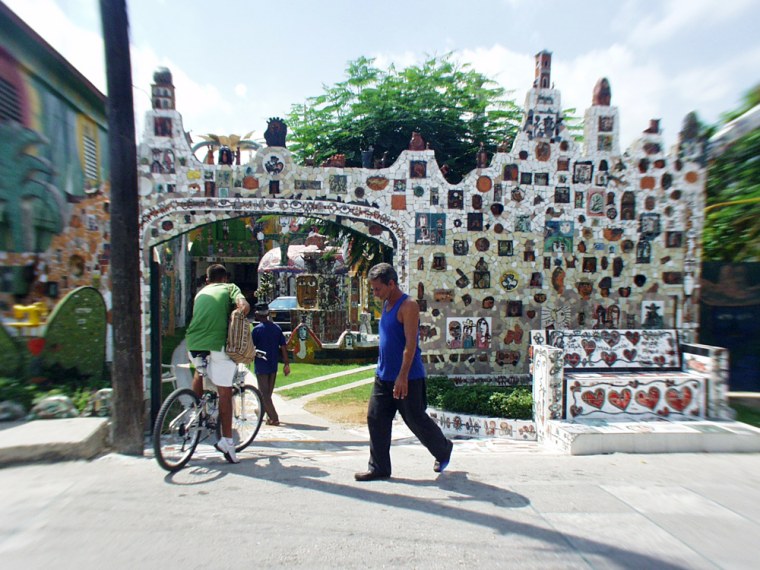It’s clear you are in Jose Fuster’s neighborhood well before you reach his home.
There’s the widow’s house with a roof that looks like an overturned saucer decorated in a blaze of ceramic tiles and capped with a small Afro-Cuban statue; then there’s the doctor’s office, painted a bright blue with white trim, a wall composed of a crazy quilt of ceramic tiles, a bench decorated with his folk-art figures.
Approaching his street in the Jaimanitas neighborhood, the ornate walls shout out his presence. The bold splashes of color, the zany streetscape are his calling card; they embody Fuster's philosophy of how Cuban society should work.
The artist, who has exhibited all over the world, is spending some of his earnings to improve his neighbors' homes, organizing friends to improve the quality of life in a city where few are truly starving, but most scrimp and scrape to survive.
For those without access to dollars, salaries are meager and home repairs are a luxury.
This is where Fuster helps. He is successful and happy to share his good fortune.
Yet, in the view of Fidel Castro's critics, the likes of Fuster are the new elite in Cuba, the beneficiaries of a system that rewards loyalty and punishes the disobedient.
Like his fellow artists, Fuster is barred from visiting the United States. While he has exhibited there in the past, supporters of the U.S. administration’s policy believe that buying art from Fuster is the equivalent of putting money into Castro's pocket.
Black and white?
But like U.S.-Cuban history — and Fuster’s art — it’s never black and white in Cuba.

Fuster is foremost an artist who is dedicated to his creations, a vast array of artwork from ceramics evoking the nation’s African roots, as represented in the Santeria religion, to whimsical paintings drawn from ordinary life in Cuba: commuters crowded inside creaky, smoke-belching buses, the ubiquitous dominoes games in backyards and street corners.
In person, he brings the passion of his work to his beliefs.
Fuster eschews pretension, wandering around his home-cum-studio-cum-gallery in a bathing suit, holding a beer in one hand and gesturing forcefully with the other to make his point.
Yes, he is loyal to the system, but he is not blind to its failings, Fuster says. He can criticize the government, but spits out an obscenity when asked to describe his view of Cuban dissidents.
He sees democracy at a neighborhood level in Cuba, believes that Michael Moore’s “Fahrenheit 911” is the most important “political denouncement” of the Bush administration and suggests there is little evidence of real democracy in the United States because of what he sees as the scant differences between the Republican and Democratic parties.
He deplores the U.S. economic embargo as inhuman and says it’s understandable if Cubans want to flee to the United States, “They want to own a car and a big house," he said. "They are economic refugees.”
When asked if the Cuban government shares blame for the 45-year standoff, he replied, “Maybe, nothing is absolute.”
The last supper
Fuster’s opinions are not uncommon in Cuba. Like many, especially of his generation, the artist hails the benefits of Castro's revolution, notably educational and health care systems envied by many Caribbean nations.
But he is perturbed by the deteriorating economy.
Since the fall of the Soviet Union — and the end of Cuba’s lifeline of economic subsidies from Moscow — the country has jitterbugged through a series of plans to save the nation from destitution, a fate it blames mainly on the U.S. economic blockade.
After the so-called “Special Period” of belt-tightening in the early 1990’s, Havana wooed foreign companies for joint ventures, developed a tourist industry to bring in millions of dollars and allowed some private enterprise.
But the transition has been painful; Castro views the foreign influences and hard currency as necessary evils.
More recently, authorities have stiffened regulations and cut back on licenses for private businesses such a repair shops and restaurants, apparently uncomfortable with too many touches of capitalism.
One of Fuster’s paintings, “The Last Supper,” touches on the paradox.
He explained that the diners sitting elbow to elbow around a plate of fish is inspired by the bizarre government rule that allows only 12 guests eating at one time in privately owned restaurants.
Fuster supports more free enterprise in Cuba. “These things flowered during the time there wasn’t a harsh U.S. policy toward Cuba,” he said, referring to the late nineties. “[Cubans] discovered that capitalism gave a little source of comfort.”

Fuster sees the problems. “That is something that we as Cuban society face,” he said. “Some doctors are going to ride a bike, and they are sometimes the heart surgeons, while those who own restaurants have big cars and lots of money.”
The artist said it was a “difficult bridge for socialism to cross,” but insists the Cuban system is resilient and will remain intact, even after Castro.
Castro opponents and many analysts predict a sea-change in Cuba after the 78-year-old leader dies.
Fuster compared Castro's death to a partial eclipse of the sun.
He added, “If you ask me what is going to happen if there is no more revolution, it will be a total eclipse of the sun.”
